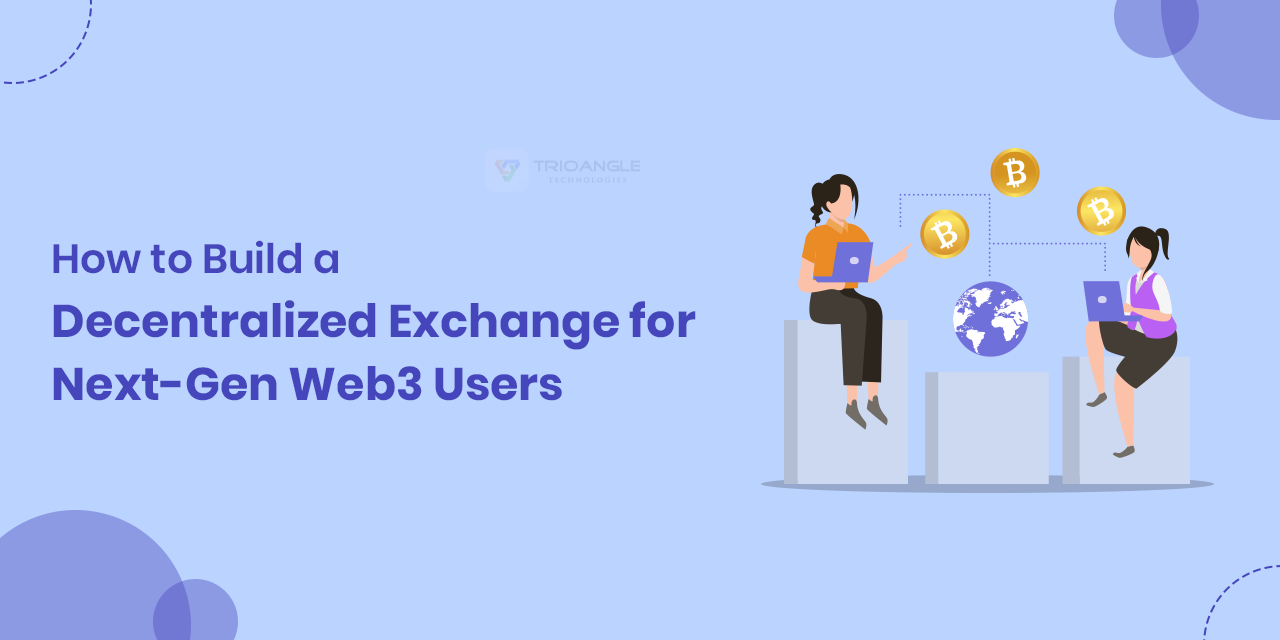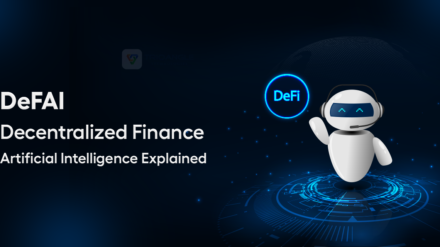You’ve opened this blog because you have an idea of building your own DEX platform, right? So, you have made the right decision. Many entrepreneurs are switching to the DeFi space to start their crypto ventures today. As a result, the competition is increasing, and standing out in this sector is a big task for many DEX owners. You must build your DeFi platform to satisfy future traders’ expectations, and you need to aim for long-term growth. In this blog, let me tell you “How to Build a Decentralized Exchange for Next Gen Web3 Users”.
So, before diving into the “how”, let’s understand “why” it’s important to build a DEX for next-gen users.
Let’s Begin With The “Why”
When you plan to invest your time, money, and effort into developing decentralized exchange software, it’s important to understand why users are turning to DEX platforms and what opportunities lie ahead.
So, here I’ll list out what they are…
- The 2025 Q1 reports show that the people around the globe hold over $2.7 trillion worth of cryptocurrencies (approx). A big part of this was traded on decentralized exchange platforms.
- More than 20% of crypto trading volume was now handled by decentralized exchange software. The best part is that these numbers are growing every month.
- Because of stricter rules on the centralized exchange, more users are stepping into the decentralized solution to gain control and transparency over their crypto funds.
This data acts as proof for why you need to build a decentralized exchange for next-gen Web3 users. There are many DEX platforms that exist in the world, but do you ever think why a few are more popular?
Well-known DEX platforms build decentralized exchanges by considering their users’ needs. If you need to create a successful DEX trading platform, then you need to…
Understand Your End Users
Many entrepreneurs and startups fail in this chapter. Most of them focus on the tech stack and implementing attractive layouts. They won’t think about users’ expectations. However, providing what users expect will attract more users to your solution. Without users, an advanced tech stack and attractive layouts are simply a waste.
Today’s web 3 users are expecting:
- Mobile-friendly solutions, and fewer users care about desktops.
- DEX platforms that need to connect with multiple blockchain networks, like Ethereum, BNB Smart Chain, Polygon, and more.
- Users are expecting a user-friendly experience, with simple and smooth onboarding processes.
- They care about the platform’s security, even if they aren’t tech experts.
- Users explore reviews, feedback, and community opinions before stepping into any platform.
These are the first things you need to keep in mind before thinking about “how to build a decentralized exchange for next-gen web 3 users.
User expectations are high today—just imagine how much higher they’ll be in the next generation. That’s why it’s important to hire a decentralized exchange development company that can build a DEX tailored to their needs. They will be a great partner in bringing any of your DeFi business ideas to life.
So, it’s the perfect time to jump into the core concept on our topic now.
How To Build a Decentralized Exchange That Attracts Web3 Users
To bring your DEX platform to the real world, you need to make the right decisions regarding some important factors.
Here’s what they are:
#1. Decide What Kind Of DEX You’re Going To Build
This is the first thing you need to think about when you want to build a decentralized exchange. You need to decide which type of DEX platform you want to develop. Think whether you need,
- Automated Market Maker (AMM) Based Exchange Platforms: These protocols use advanced algorithms to match trades effectively. It utilizes liquidity pools to provide a smoother trading experience for its users. Think “Uniswap,” for example.
- Order-Book-Based DEX Platforms: These DEX software match buy and sell orders directly. Order book DEXs are ideal for attracting professional crypto traders. “dYdX” will be the perfect example of a hybrid platform.
- Hybrid DEX Platforms: These platforms combine AMM and order book features in a single place to offer better liquidity. It attracts both beginners and trading giants to make profitable trading.
Next…
#2. Build Smart Contracts That Are Truly Smart
Smart contracts serve as the decision makers for your decentralized exchange software. Keep in mind, you must plan to set perfect working mechanisms for your platform during smart contract development.
These self-executing contracts handle platform activities like:
- Token Swaps.
- Liquidity provision.
- Yield farming and Staking.
- Fee Distribution.
- Governance (If you add DAO to your platform).
Moreover, well-crafted smart contracts can lead your platform to success. They must be thoroughly tested to prevent vulnerabilities and avoid hacks.
Then…
#3. Focus On Creating a User-Friendly Interface
Most users don’t care about your back-end tech stacks if your front-end is confusing. You need to implement easy-to-navigate layouts to gain user retention and to provide a better trading experience for your users. Seriously, a DEX platform’s user interface can make or break things.
Moreover, your layout needs to be easier for a beginner, too.
A best user interface should:
- Navigate a new user from wallet connection to token swap without any confusion.
- Need to display information, such as fees, slippage, and estimated outputs, clearly.
- The layout should be easier to use on both mobile and desktop.
- Your DEX should enable fast switching between networks and tokens for a hassle-free experience.
Additionally, you can add these features to enhance your user experience on your DEX. They are:
- Dark/light mode toggles.
- Multi-lingual support.
- Real-time token tracking.
- AI-driven trading tips.
If you want to build a DEX, strategic user interface considerations are more important.
And then…
#4. Plan Liquidity Like a Pro
Without liquidity, your platform is like a ghost town, no one comes into it. You need to build a decentralized exchange that attracts liquidity from the beginning. So, now you might think,
“How can I enhance liquidity on my DEX software?”
To enhance liquidity, you must,
- Offer rewards to liquidity providers using your native token (If you have one).
- Collaborate with well-known projects to list their token pairs on your platform.
- You can use cross-DEX routing to pull liquidity from other platforms.
Next…
#5. Plan Tokenomics Carefully (If You’re Launching a Token)
If you plan to launch a native token for your platform, it’s a great idea, but you need to determine the tokenomics correctly. Without the reliable tokenomics, your token won’t gain any real value.
A good tokenomics should answer these questions:
1. For what is this token used for?
2. Who gets the token, and why do they get it?
3. How is the token’s supply managed? Is it fixed, inflationary, or deflationary?
4. Is the token used for governance (voting) or mainly for earning rewards?
Keep this in mind: Good tokenomics = steady growth. Bad tokenomics = quick hype, then a drop.
And then…
#6. Think About Regulations and Local Laws
You’re not free from regulations if you launch a DEX platform. You need to build a decentralized exchange that aligns with the local laws perfectly.
So, you need to think about:
- Multi-signature wallets for secure protocol management.
- Look into KYC and AML requirements if you plan to operate in places with stricter rules.
- Stay updated on the crypto regulations and adapt your platform accordingly.
By keeping these factors in mind, you can dive into decentralized exchange development now. But I’ll give you a bonus point that’s worth exploring.
#7 Bonus Point
Blockchain selection is one of the important decisions to be taken correctly when you want to build a decentralized exchange software.
You can pick the right network by exploring the top blockchains to build a DEX. You can equip Ethereum, BNB Smart Chain, and others as per your business needs. You can implement layer 2 solutions on your decentralized exchange platform to gain optimal performance.
Additionally, you can use AI-driven services on your decentralized exchange solution. For example, AI-driven analytics or AI-driven performance metrics. This helps to attract many Web3 users. Because DeFAI (decentralized finance artificial intelligence) is gaining more popularity in the DeFi space now.
Right. Now you’ve explored all the valuable information to build a DEX. But, developing a DEX platform requires mountain-level experience; it’s not as easy as developing normal software. You need a reliable partner to create your DEX platform.
So, now you’re wondering, which is the best decentralized exchange development company for building my DEX platform?
The perfect answer is Trioangle, a most trustworthy and reliable development partner for developing a DEX platform.
But…
Why Choose Trioangle For Decentralized Exchange Development?
Trioangle operates as one of the most successful decentralized exchange development companies in the crypto industry. With highly experienced blockchain developers, we create efficient DEX platforms to match your vision. By partnering with us, you don’t want to think about hard technical hassles, we take care of everything. From requirement gathering to product deployment, Trioangle stands with you to build a decentralized exchange that stands unique in the DeFi space.
Want to build a decentralized exchange?








